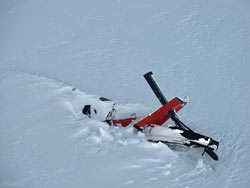Kenn Borek Air Twin Otter Crash--23 January 2013 Twin Otter KBC (the aircraft lost in the crash) at the Moraine Canyon field camp in the CTAM on 10 January 2011 (Peter Rejcek, Antarctic Photo Library) June 2014 update...a Transportation Safety Board of Canada (TSB) report was released on 20 June 2014, indicating that the cause could not be identified (CBC 20 June coverage). Earlier, in May, New Zealand's Search and Rescue Council recognized the USAP for their support and cooperation in the crash investigation (NSF press release and a Christchurch Press article). Below, 3 photos from TSB investigation page: | ||
|
June 2013 update: an inquest into the crash was held in Auckland on 12 June. Much of the information presented was a result of the SAR team's efforts--they were first able to reach the crash site by helicopter on 27 January. This was at 13,000 feet on the side of Mt. Elizabeth, as described below. The SAR team recovered the cockpit voice recorder; it was analyzed by Canadian authorities, but it did not contain any audio from the time of the crash. The team also recovered crew identification documents and took photos of the crash site. Based on the presented information, the coroner ruled that the three Canadians, Robert Heath, Perry Denton, and Perry Anderson, died from multiple injuries received from the crash impact. Further efforts to recover the bodies of the men had been considered for the 2013-14 summer season, but these were cancelled. Media references include 12 June articles from stuff.co.nz which includes several SAR team photos at the crash site, and from The New Zealand Herald, which includes this link to 9 photos. This Twin Otter, operated by Kenn Borek Air (KBA) out of Calgary, was at Pole on Wednesday 23 January...the crew, pilot Bob Heath from Inuvik, NWT; copilot Mike Denton of Calgary, and Perry Andersen of Collingwood, ON, had been there for nearly two days, they thought they were done with their Antarctic activities and were preparing to fly to Rothera, en route back to Calgary. But they received a call from their office that plans had changed, and they were needed at Mario Zucchelli Station, the Italian base in Terra Nova Bay about 220 miles north of McMurdo. Late that afternoon they took off... At 2200 that evening, they missed their hourly checkin with Mac Center, and the emergency operations center at McM was activated. Shortly afterward, the aircraft's ELT was detected by the rescue coordination center in New Zealand. The signal was transmitting from near Mt. Elizabeth, near the Beardmore Glacier about 420 miles south of McMurdo, halfway between McMurdo and Pole. Bad weather in the search area (overcast conditions and 90 knot winds) prevented any immediate search activity (NSF press release). The next day (Thursday), an LC-130 circled the search area for several hours, and a Basler later did the same, searching for about five hours, but nothing could be seen due to the heavy cloud cover ( a Thursday SP time Globe and Mail article and coverage from stuff.co.nz/the Christchurch Press).
Several news articles, most recently this one in the Saturday 26 January Christchurch Press, reported that former Kenn Borek general manager Steve Penikett had been tracking the flight online while at his current job in Kabul...he observed the Twin Otter flying at 13,000 feet, when it suddenly dropped to 8000 feet, climbed back to 13,000 feet...and suddenly stopped. I heard from a good Polie friend who had negotiated a contract with Steve for USAP Twin Otter support in the 1980's--his statement to me was, "If he says it flew into a mountain, it flew into a mountain.") Several more search flights were conducted on Friday and Saturday. Shortly before noon Saturday, an LC-130, after departing CTAM, made an initial sighting of the downed aircraft. The sighting was confirmed about 30 minutes later by a KBA Twin Otter. The overdue aircraft had impacted a very steep snowy mountain slope, there was no visible sign of activity, and it appeared that the crash was not survivable. At 1915 two helicopters also sighted the wreckage, but they were unable to land nearby (the NSF press release; a report from CBC News with video; some Christchurch Press coverage; and reports from Kenn Borek Air).
On Sunday, two helicopters reached a site approximately 1000 feet above the crash, and the search-and-rescue team made its way to the wreckage. They were able to recover some equipment from the exposed tail--including the cockpit voice recorder, but they were unable to safely access the remains of the crew. The crushed aircraft was packed with snow and debris as well as leaking fuel from the auxiliary fuel tank inside the fuselage, and there were signs of avalanche activity and crevasses in the area. The cockpit voice recorder was to be sent to Ottawa, as the Transportation Safety Board of Canada would be investigating the crash. After reviewing information from the crash site, Antarctica New Zealand and the U.S. Antarctic Program jointly determined that it was too dangerous at present to recover the bodies of the aircraft crew this season--here are their announcements: from NSF, and from Antarctica New Zealand (ANZ). Significant news coverage: this 28 January Christchurch Press report...and also this CBC news report which includes video of an interview with NSF media representative Peter West, depicts the coordinates of the crash site, and discusses speculation by the NZ Rescue Co-Ordination Centre that the aircraft had been on its proper course through the mountains but may have turned too early.
Here is the Kenn Borek Air memorial page.. Although consideration was given to a recovery effort in 2014, this was called off, and so far as I know there were no further returns to the crash site (7 October 2013 Christchurch Press article). Here is the accident investigation report from the Transportation Safety Board of Canada, last updated 20 June 2014. | ||






